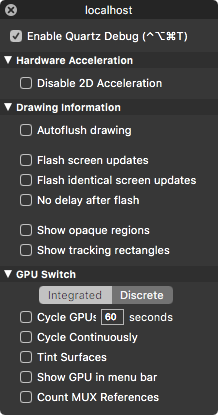Quartz Debug For Mac
Using Quartz Debug was somewhat enlightening for me; I don't have a ton of icons on my Desktop (about 10 or so), but each one clearly uses up a chunk of memory. I didn't notice any speed bump from reducing the number, given the small number I had to begin with. Quartz Debug (Mac abandonware from 2007) To date, Macintosh Repository served 1241652 old Mac files, totaling more than 235756.4GB! The quartz-wm window manager included with the XQuartz distribution uses the Apple Public Source License Version 2. Look at most relevant mac quartz debug download websites out of 169 Thousand at KeywordSpace.com. Mac quartz debug download found at forums.developer.apple.com, idownloadblog.com, manualenergy.web. Before reaching out to others, take a look at the FAQs.Your question may already be answered, but if not, there are three ways to get support for XQuartz.
Apple has already begun the process of bringing Retina graphics to their non-Retina Macs – but for many users (or developers testing Retina apps), the process isn’t happening nearly fast enough! There is a way to get a taste of what Retina graphics would look like on your Mac ahead of time, however – and Apple has provided instructions for exactly how to enable Retina graphics on your non-Retina Mac!
Before you can enable HiDPI (‘Retina’) mode, you must download and install Xcode from the Mac App Store. Once you have Xcode, you’ll need to install Quartz Debug. To download Quartz Debug

- Open Xcode.
- Choose Xcode > Open Developer Tool > More Developer Tools.. Choosing this item will take you to developer.apple.com.
- Sign in to developer.apple.com. You should then see the Downloads for Apple Developers webpage.
- Download the Graphics Tools for Xcode package, which contains Quartz Debug.
Once you have successfully installed Quartz Debug, you’re ready to enable HiDPI modes on your Mac. Here’s how it’s done:
To enable high-resolution display modes
- Launch Quartz Debug.
- Choose UI Resolution from the Window menu.
- Select “Enable HiDPI display modes”.
- Log out and then log in to have the change take effect. This updates the Resolutions list in System Preferences.
- Open System Preferences > Displays, and choose a resolution that is marked as HiDPI.
Now that you’ve completed all of the steps, you’re ready to start checking out Retina graphics on your non-Retina Mac! Enjoy!
Quartz Mac
For more helpful tips, check out our full collection of tutorials by visiting our How-To category!